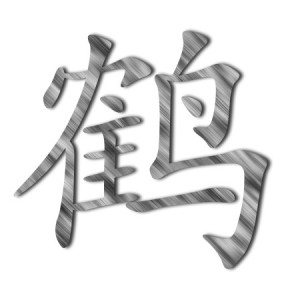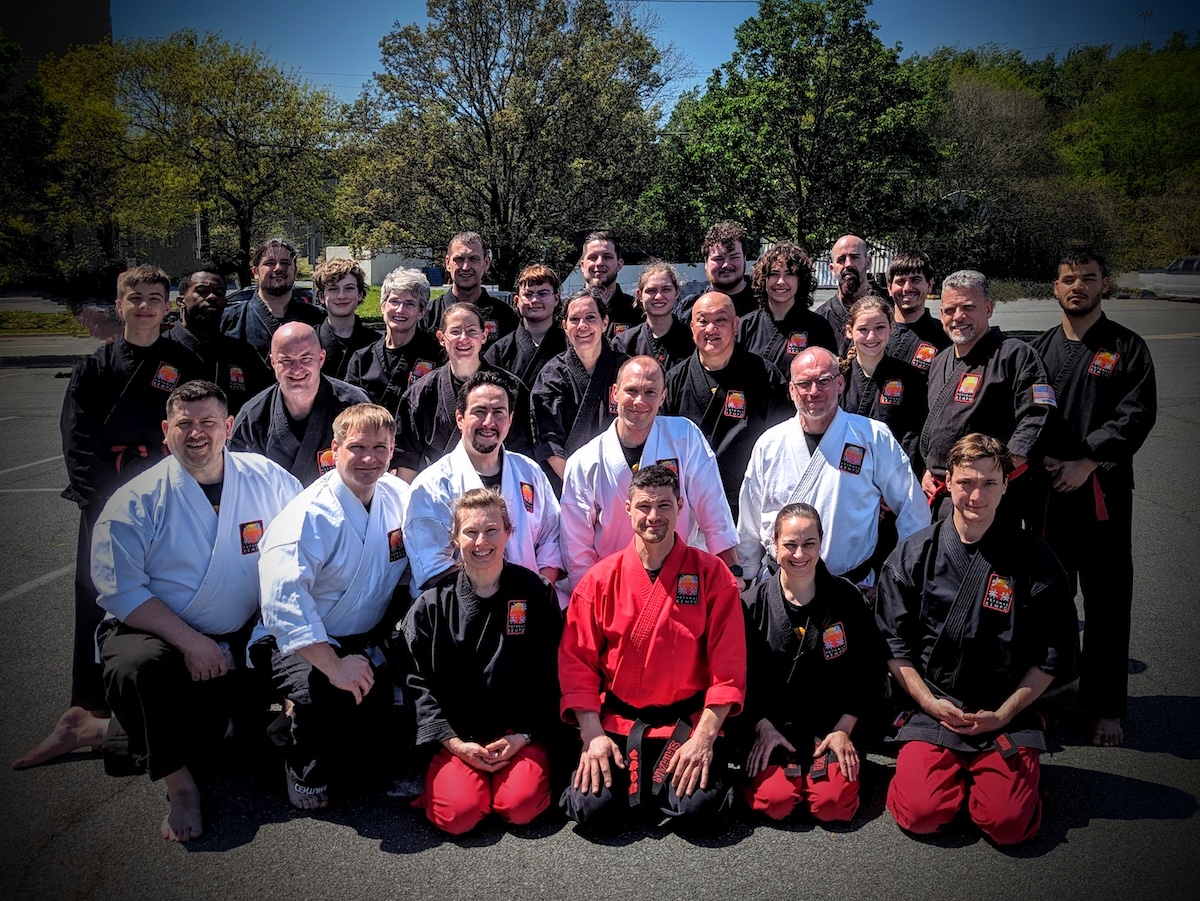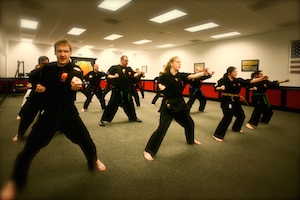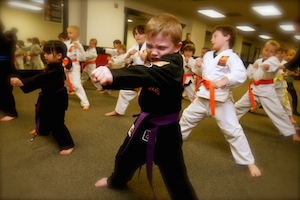The exact origins of the Crane as an animal of interest are lost in legend but most legends agree that it all started in Tibet. Thousands of years ago Taoism traveled to China through the Kunlun Mountains of Northern Tibet. With it came a reverence for the Crane as a symbol of Longevity, Centeredness, and Resolve. Through the years Taoism and Buddhism influenced each other. Today, Chan Buddhism, the school of Buddhism developed at the Shaolin Temple, shares many similarities to Taoism. The Shaolin emphasis on total absorption in the practice of a highly cultivated skill — kung fu — was originally a Taoist ideal.
Legend further says that it was a Tibetan Monk who first developed a fighting art based on the Crane. The stories vary but they all revolve around a consistent thread. A man — sometimes described as young and sometimes described as old — observed a Crane defending itself and was inspired to create a fighting style based on the movements he observed. In different versions of the story the Crane fights different animals, sometimes a Fox, sometimes a Gorilla, sometimes a Tiger, and in one version the Crane is defending against the man who is trying to shoo her away with a broomstick. In all cases the Crane is the defender, never the instigator; in all cases the Crane is victorious.
The Crane always defeats her opponent by using her wings and long neck to maintain distance while slowly wearing down her opponent with quick strikes to his vitals. In between defenses the Crane always Exists in Stillness, balanced in the center and ready to move in any direction to evade. The opponent always limps away defeated while the Crane returns to stillness to recenter herself and rest.
Fighting Style
The Crane has a defensive character, like the Dragon, choosing to avoid confrontation and evade whenever possible. In the television series, Kung Fu, Master Kan teaches what might be considered the philosophy of the Crane.
Avoid rather than check. Check rather than hurt.
Hurt rather than maim. Maim rather than kill.
For all life is precious nor can any be replaced.
This desire to evade and avoid is, in part, informed by her diminutive size. Her body is small and frail and it is imperative that she minimize the risk of contact with her opponent. She succeeds by maintaing distance in three ways — discussed here in decreasing order of preference. Ideally she is able to evade, moving away from her opponent at an angle. Once there she will use a long range strike, either a kick or extended hand strike to attack a vulnerable area. She will use this method repeatedly, but if her opponent presses through this range she will resort to establishing distance with her limbs, perhaps by raising her knee or extending an outward shuto. If an opponent overcomes this level of defense she will employ Chin Na, manipulating a small joint or striking a pressure point. She will then take advantage of the opening this creates to reestablish distance.
In this way, the Crane is able to minimize risk to herself while slowly overcoming her opponent. In an optimally executed evasion the Crane will receive no injury while scoring a strike to her opponent. This strike will be minor compared to the damage caused by, for instance, an aggressive Tiger attack, but it will come at little cost to the Crane. The Crane will also use far less energy than her opponent by Existing in Stillness. Thus she is striking her opponent, avoiding injury, and conserving her strength. Over time this combination will give her an ever-increasing advantage over her opponent.
There are a couple of elements that are required for an optimal evasion, and in them we come to understand the nature of the Crane. As an opponent attacks, the Crane must be perfectly balanced, ready to move in any direction. Being anywhere except in the center predisposes one to move in a particular direction, which will result in failure in one of two ways: either the evasion will be too slow — having to overcome the predisposition to move the other way — or will be in the wrong direction — the direction predisposed toward, rather than the optimal direction. In order to avoid injury the Crane must be balanced and centered at all times.
Further, evasions require waiting for commitment. Until an attack is committed to, the opponent can redirect it or even retract it. Thus, most attempted evasions are stymied by one attempting to evade prematurely, allowing the attacker to change the nature of their attack. Only by waiting for the attack to become fully committed can the Crane succeed in evading it. And so we find in its character the patience that has long been associated with the Crane.
The Crane does not seek to win,
The Crane simply seeks not to lose.
As we observe the Crane’s fighting style in its entirety we see that she is — for the most part — simply trying to avoid fighting at all. Though she offers a counter to every attack, she does not, in fact, ever instigate an attack. If at any point her opponent chooses to limp away, she will let them, as she did in the legendary stories of her origin. The Crane simply wishes to Exist in Stillness and not be bothered.
Maintaining Distance
As discussed, when the Crane is attacked she will tend to evade, moving back obliquely. She will then very quickly set and launch a targeted counter, using her superior extension to reach a vital area. This works well against most opponents who tend to attack with one, two, or maybe three strikes. The Crane methodology is, however, susceptible to a Tiger attack. The Tiger, with his incessant charge will continue forward, break through the Crane’s weak counterstrike and attack the Crane again as she attempts to reset herself. Not yet centered, she will not be able to evade again. She will attempt to establish distance with one or more of her limbs, perhaps extending a wing or raising a knee. The Tiger will tear through the wing and — if she raises a knee — take advantage of her single-leg stance by knocking her down. She’ll never get a chance to employ her third line of defense; it will already be over.
That said, the Crane is strong against the Snake. The Snake wants to entwine the Crane and use his superior size and strength against her. Fortunately, the Crane’s natural set of defenses work quite well against this. When the Snake tries to close distance the Crane will evade and counter. If the Snake gets closer, the Crane will raise her knee or use a defensive wing. In the unlikely event that the Snake gets past that line of defense the Crane will alternately strike at vital points and break small joints until the Snake releases its hold and the Crane can reestablish distance. This will continue until the Snake is too tired to persist.
Not surprisingly, given its nature, the Crane will never fight another Crane. If two Cranes faced each other they would both Exist in Stillness until the sun set. Some would consider the confrontation a loss for both of them. Cranes would consider it a victory.
Striking and Blocking
As mentioned, the Crane is small and frail compared to most other animals. A Tiger can strike to any part of the body, even resilient parts like the chest, and see some effect, the Crane cannot. The Crane will never attempt a strike to a resilient part of the body, instead focussing on vital points such as the eyes, throat, temple, groin, floating ribs, and solar plexus. Her strikes will be extended, allowing her to counter from a distance as she prefers.
For hand strikes she will use a Flying Wing, also called an Inward Forearm or a Ridge-Hand, often to the temple, jaw, or floating ribs; she will use a Downward Shuto to the clavicle, or if her opponent is already bent at the waist, to the back of the neck; she will also use an Outward Shuto, though mostly defensively to the throat to establish distance. She will form a Cranes Beak, all five fingers together, to vital areas, especially the eyes; she will use a Crane Wing, more commonly called a Spear-Hand, generally to the throat; also a Honshu, or Finger Rake, drawing outward with the ends of her fingers to the eyes. Lastly, and most viciously, she will use a Demon Claw, extending the first and second fingers into the eyes and the thumb under the jaw.
Because of the range requirements of her fighting style she favors kicks. She will use all kicks, especially Roundhouse Kicks and Side Kicks, taking advantage of their long range and ability to work from an angle. She will kick low or high as openings present themselves. Moreover she will hide kicks in her steps; stepping right to kick left and vice versa. In some cases each step will, in fact, simply be a cover for another kick, never allowing her opponent to close distance.
She will, when possible, evade and check strikes with extended Knife-Hands and Parries. The only time the Crane will use a “bent wing” is when defending and absorbing a strong attack. When a more powerful attack pushes through her block she will allow her wing to bend and then ‘throw’ the attack away, with a large and powerful sweep of her wing. Done correctly this redirection will shift not only the arm, but their entire body — often opening a vital area for a follow-up strike.
Physical Characteristics
It goes without saying that the Crane has superior balance. She can stand on one leg for hours and remain centered and balanced in the most violent of storms. She achieves this skill through arduous training, focussing not only on stillness but the transition into and out of each position. These movements must be as balanced as when she is stationary. Usually people picture standing on one leg when considering balance, but all stances require balance — some are simply more challenging than others.
The Crane will practice her balance on Plum Flower Poles or their equivalent. Plum Flower Poles are posts set in the ground, often with one in the center and four around the outside, not unlike the blossom of a Chinese plum tree. In lieu of actual posts, any raised surface will suffice. Even marks on the ground can be used as a starting point — but being elevated creates an injury risk that helps people to focus.
More than any other animal, the Crane is dependent on impeccable timing. Evasion, her preferred fighting tactic, only succeeds in precisely the right moment. By practicing patience like the Crane, we too can develop this perfect timing.
Further, the Crane is startlingly explosive. She patiently waits for the appropriate time to move, and then explodes with grace and aplomb. She then returns to stillness once more. The explosion is critical to her fighting methodology. Having impeccable timing is not sufficient if your response is sluggish. In fact, the more explosive her response, the more precise her timing can and must be.
We also find that her balance and penchant for fully extended movements creates a graceful and beautiful fighting style. The effect is fluid and powerful because even as she is transitioning between movements she is alway perfectly balanced. Her fully extended arms and legs save her from the choppy and crude style that afflicts some of her peers. Her movements are, instead, graceful and connected. Further, the use of full extension trains the body, giving it the strength and the control to strike from afar without overextending. This feature alone gives the Crane a tremendous advantage over her adversaries.
Mental Characteristics
Typical discussions of the Crane focus on balance as one of her core traits. However, the reality is that physical balance is an outgrowth of the mental state of centeredness. Balance is perhaps easier to understand in its physical form, but is much more powerful when applied to mental capacities.
Often crudely defined as not falling over, physical balance actually is much more subtle. Think of it in these terms: if you go too far to the left, you will fall to the left. If you go too far to the right, you will fall to the right. As such, balance is not going too far in any one direction. In parallel, being centered means not going too far in any one direction in a more abstract sense. If a person commits too much energy to their job they will be ‘falling away’ from other things, like their relationships. If they spend too much energy focussing on their relationships, they will be neglecting their job. It is more challenging because there are many more directions to ‘fall’ in a mental context than ever there could be physically.
With regard to good physical balance, there is more to the equation than simply not falling over. True balance is only achieved when your center of mass is centered over your standing foot or feet, your spine is straight, eyes are focused, and muscles are lightly tensed. Likewise, what constitutes being ‘well’ centered is often understated. Being on the edge of falling toward or away from something — but not quite falling — is not real centeredness any more than being on the edge of your heel constitutes true balance. We are truly centered when we find that still place in our minds where all things in our lives pull us gently — and equally — in every direction. Our compulsion to go to work is perfectly balanced by our urge to develop our relationships, which is well countered by our desire to exercise, etc. In this state — and only in this state — we can do and be anything. Only in this state can we reach our highest potential.
Existing in Stillness
In the eyes of the Crane most people react too quickly to life’s events; they act without waiting for the fullness of time to reveal everything there is to know about a situation. Translated into fighting terminology this is equivalent to saying that people tend to respond before an attack is fully committed, making it possible for it to be retargeted or withdrawn. In the words of T.S. Eliot, most people tend to “force the moment to its crisis,” where the Crane would rather let it unfold naturally. There is an old Shaolin saying that, “The spirit of the Crane resides within the stillness.”
This demonstration of patience reveals the Crane’s strategy. She will not waste her energy reacting prematurely or worrying about situations before she has all relevant information. That said, by Existing in Stillness, she will not tackle problems until they reach their crisis. She won’t start projects and she won’t lead a charge. She will never be in the vanguard, preferring to manage the defense. She shines in many situations but doesn’t know how to operate outside her comfort zone.
Lao Tzu advises us to “Withdraw as soon as your work is done.” The Crane lives this philosophy to a fault. She can be none other than what she is, but we can choose how to approach each situation we encounter. For defense, especially against a more powerful opponent, by Existing in Stillness we will often be victorious. However, for offense we must seek counsel elsewhere.
In Summary
The Crane is a revered and beautiful symbol of centeredness and patience. She teaches us to not react prematurely, insist on a distance that is comfortable for us, and Exist in Stillness all the while. In this way she shows us how we can overcome nearly anything.
She shows us that we don’t have to feel pulled in every direction. If we find the place where the tension is equal in every direction we won’t feel pulled at all. When we find that place where everything is balanced we will be at our true center and we can be at peace.






